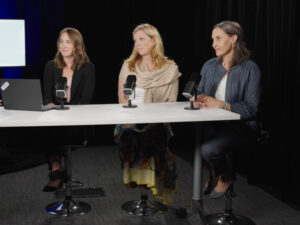Materials Matter in Our Climate Change Fight … Here’s Why
On this episode of Here’s Why, we’re talking about materials and why they matter. Everything that goes into making our everyday products is sourced from a variety of different places. How we source those materials is an important step in building our sustainable future. Our guests today are not only focused on new materials discovery, they’re also focused on efficiencies, reducing waste, and lowering manufacturing costs, all in the name of combating climate change.
Transcript
Host:
- Kristen Delphos, vice president of communications and public relations, UL Research Institutes (ULRI)
Guests:
- Gavin Towler, corporate chief scientist at Honeywell
- Stuart Miller, vice president and executive director, Materials Discovery Research Institute (MDRI)
Kristen: Hi, everyone. I’m Kristen Delphos, vice president of communications and public relations at UL Research Institutes, and I’m excited to welcome you to our podcast: Here’s Why. Today we’re here to talk about materials and why they matter. Everything that goes into making our everyday products is sourced from a variety of different places. How we source those materials is an important step in building our sustainable future. Our guests today are not only focused on new materials discovery, they’re also focused on efficiencies, reducing waste, and lowering manufacturing costs, all in the name of combating climate change.
So thanks for joining us today for our Here’s Why podcast. We’re here recording at our first inaugural UL Research Institutes Research Symposium. With me today is Stuart Miller, who is vice president and executive director of our Materials Discovery Research Institute, and our guest, Gavin Towler, who is the corporate chief scientist for sustainability at Honeywell. Thank you.
So Stuart, you have a session that’s at this symposium where you’re going to talk a little bit about your institute and some of the things that you’re focused on. Can you share a little bit about that?
Stuart: Excellent, yes. We will be looking at materials processes to help resilience for a sustainable future, so we have presentations from distinguished professors from academia, including Professor Alan Aspuru-Guzik, Professor Paul Wright from the University of St. Andrews, and Professor Omar Farha from Northwestern University. After which, we’ll have a panel discussion that will include Mr. Ben Hernandez from Newmark Technologies, Dr. Gavin Towler from Honeywell, and Dr. Philippe Lu Ellen from Total Energies. So the idea is to look at the transition from materials in an academic setting through to the industrial application of them to address some of the issues that we have coming from climate change.
Kristen: OK. And climate change is something that’s come up virtually in every session. One of the things that makes UL Research Institutes special or even the UL Enterprise as a whole is our ability to convene stakeholders to have these kinds of discussions. So Gavin, you’re here from Honeywell. What are your thoughts about why it’s so important for your point of view, or Honeywell’s perspective to be part of this conversation that we’re having?
Gavin: Well, obviously, global warming is a global challenge, right? Sustainability is a global problem. As Honeywell, we’re a business to business company and we’re in multiple different industries. So prior to my current role, I was leading technology for the performance materials area, which serves the energy and chemicals industries, but we also have a very big aerospace business, buildings and automation and safety and productivity solutions. So we touch a lot of different companies, and as a supplier of technology, all of our customers want to know how we’re making the technology more sustainable, how we are making lower greenhouse gas impacts, lower energy use in all of our technologies, and of course how we’re making things safer. So we spend about 60% of our R&D money and about 60% of our products are things that either address environmental performance or safety and resilience. It’s really a very big part of what we do as Honeywell, and so it’s very interesting for me to be here and to have this interaction with UL because obviously safety, sustainability are a very big part of what UL does as well.
Kristen: Sure. And so when we think about materials discovery, how is that process or what that means different in an organization like Honeywell, which is a commercial or in an industry, versus the sort of research that we are doing at UL Research Institutes?
Gavin: I would say the main difference in a big material supply company like Honeywell is that we think about doing things at scale. So we have to think about manufacturability right from the very beginning, and about the supply chain, where the demand is going to be and how we’re actually going to manufacture the final end materials. So it’s a much more constrained problem than when you’re in a university. In a university, you’re free to work on whatever sparks your curiosity, and you can come up with some very, very fancy materials without really worrying about what they cost. We have to be able to think through, okay, yeah, that might be a great material, but if you’re going to make hundreds of thousands of tons of it, where are you going to source the supply chain, and how are you going to be able to deliver that and get the right trade off between performance and cost of the material? Which is really what our customers are looking for.
Kristen: As compared to how you are focused on materials discovery.
Stuart: I would say as compared to a university, I’m a product of the Honeywell system for 12 years, and I think if I gave a different answer to what Gavin suggested there… I am…
Gavin: You’re saying I trained you well, Stu.
Stuart: Yes. You need to look at how you solve the real-world problem, and if the economics don’t work out, it’s maybe something that will linger on a shelf until the economics do work out.
Gavin: And we’re actually seeing this quite a bit at the moment in material science for sustainability, in battery technologies. You can’t really pick up a magazine or open a website without reading something and talking about how lithium ion battery supply chains are constrained by the availability of some of the metals that are needed, and some of them are being sourced from areas where there’s conflicts and things like that. So it’s spurring a lot of research into alternative materials for battery technologies and energy storage in general.
Kristen: What kind of young people, or what would get people interested in a career in this arena?
Stuart: So I think just now, since 2015 and the Paris Accords at the COP conference, there has been intense focus on sustainability. There’s been intense focus on the climate. There’s been intense focus on making a change to live in a more energy efficient and sustainable way, and people are generally interested. We have universities around the world that are delivering phenomenal caliber engineers, chemists, physicists, that now are looking towards sustainability as a career. The transition that has to happen between a dependence on a fossil fuel economy to a sustainable economy is going to be a difficult road, and it’s going to be something that happens in collaboration with research institutes like UL and companies like Honeywell. The technology needs to be developed together. And I think bringing people to conferences like this, there’s a lot of young people at the symposium today, is giving them an idea of where they might be able to contribute in the future.
Gavin: And from my perspective, I’d say almost all of the young scientists, engineers I talk to are interested in sustainability. I mean, obviously if you’re starting your career now, you can look forward over the next 30 years and that is the timeframe in which the world is going to decarbonize and switch to much lower greenhouse gas emitting forms of energy. There’ll be a complete overhaul of every sector of buildings. Of transportation, of aviation, so a lot of demand for new technology. It’s a fantastic time to be an engineer. And anyone who’s entering the engineering science workforce can see that and see, yeah, this is going to be the life work of a generation. And all around the world, countries have set net-zero targets for 2050, 2060, 2070, so literally in the working lifetime of the young engineers and scientists. They’re really actually going to be the ones who will bring about this change.
Kristen: So they could be the ones to actually make the discovery. So instead of admiring the problem, which we all know exists today, they could come in and-
Gavin: There’s still a lot to be done. It’s absolutely true that we have all of the technologies we need to be able to fully decarbonize and to address global warming. So we have technologies for renewable power generation, for energy storage, for net-zero aviation, electric vehicles. All of these things exist, but they’re all expensive, and all of these technologies cost more than the things that they’re replacing, otherwise they would’ve been replaced already. Actually, that’s not quite true with all of them because hydroelectric power, wind and solar are now actually cheaper than hydrocarbons for generating electric power. But a lot of the technologies cost more so that means that there’s room for improvement.
And so it’s exciting if you’re a junior engineer or scientist to see so many spaces where better materials, better design methods, better optimization, can actually lead to improved solutions that will lower the cost of the energy transition. And we have to lower the cost because the amount of money the world needs to spend is about three to $5 trillion a year from now through 2050. And the whole energy infrastructure at the moment, we spend about one and a half to $2 trillion, so we are not actually changing the energy systems at the rate we need to. We can get there, but of course, to the extent that we can make those technologies better, it becomes easier to implement them.
Kristen: So you have to be quite the optimist to think that you could quickly make a difference. So I’m looking at you, Stuart, because you left the comfortable world of corporate America, to the extent that it’s comfortable, to join a nonprofit and stand up an entire institute focused on this.
Stuart: And there’s two things I’d say to that. One of them, there’s a lifetime of work for engineers ahead of us and one of the things that really attracted me to UL is OREE, the Office for Research Education and Outreach. Please tell me I got that right.
Kristen: Research Experiences And Education.
Stuart: Research Experiences and Education. But I feel that we need to be able to give back, and I genuinely believe that some of our key stakeholders are educators and kids in school to get them interested because they will solve these problems. And then working with Honeywell, one of the things that I saw and I think Honeywell does beautifully well, or UOP does beautifully well, is miniaturize and have combinatorial experiments so that you are doing as many different experiments, capturing as much data points as possible, and that means that you learn from your failures. That means that you can have a high throughput approach to solving a problem.
So the way that you solve the problem is you tip the scales to your advantage. You begin to move where you can go, and this is what we’re doing at MDRI. We’ve invested a lot of money in high throughput robotics for materials discovery, high throughput’s characterization. And we’re not just interested in developing the material, but we will work up through into TRL 7 to develop the prototype so that when we do engage with companies, we’re not coming to them with a solution of a material. We’re coming with a prototype solution that works in a real world environment.
Kristen: So if everything goes right, what’s the tipping point for things to turn in our favor where it doesn’t feel like a doom and gloom conversation around climate change?
Gavin: I think it’s important to understand that there’s no break point where everything goes terrible versus everything goes great. If we had no further global warming at all, we can already see at the moment, we’re at about 1.3 degrees relative to 1850 now and we can already see the wildfires, the floods, the extreme weather events that are already happening. So it’s not like there’s no impact, even if we completely cut off all greenhouse gas emissions now. But what we do have to understand is that if we don’t act, it’s going to get a lot worse. So that’s the imperative. That’s why the Paris Agreement set the target at two degrees, but with an aspiration to hit 1.5. 1.5 is still doable, but it really needs action in the next five years. And the recent AR6 report from the IPCC basically said, we’re not doing enough, we’re not moving fast enough.
So I think the increased frequency of extreme weather events is really getting everybody’s attention. People are realizing that this is not some theoretical thing that a bunch of physicists dreamed up that may or may not happen. No, the IPCC says that the likelihood of extreme weather impacts due to climate changes is confidence in the 95 plus percent range, so we’re actually seeing it. And so we need to move faster, and the faster we move and obviously the quicker we can decarbonize and carry out the energy transition, then the less global warming there will be.
And what sort of range are we looking at? Well, if everyone really were to get behind this and move very fast, we can still hit the 1.5 target. If all the countries hit the targets they’ve signed up for net-zero economies by 2050, 2060, we’ll come in under two. And if nobody does anything, we could still end up in the threes. And the impact of that could be very, very severe in terms of flooding, weather events, droughts, all kinds of things that are going to happen if we don’t bring global warming into control.
Stuart: I think you mentioned a tipping point. I think we’ve had that. We have awareness now. Climate change and global warming isn’t new. It never started in 2015. People spoke about it in the 1960s and the 1970s, and they were opposed. They were villainized. People now accept it as science. So that tipping point has happened. It’s how fast can humanity act to put in place the procedures to stop it getting any worse?
Kristen: So a lot of what we’re talking about on this podcast is how to make some of these things relatable to the general educated public, so we talk about lithium ion batteries and we carry them around so we should know how to make them safer, how to treat them more safely. Sometimes in the conversations about climate change, it seems so daunting that I don’t know that an average citizen might even think about what they could do because it seems like they have to solve this problem. But what is something that every household, every family or every individual might think about doing that would maybe contribute to making the work of institutes and organizations like yours easier?
Stuart: So I can start, and just simple energy efficiency tips. Much of our emissions come from our energy sector, and if we are more careful with our energy and more energy efficient appliances, we can reduce our emissions simply through the choice of our products that we purchase. We can also… ESRI has a fantastic campaign on be nice to your device. We can look at things like battery technology and how we recycle that battery technology as well. So there’s a lot of energy saving and carbon emission savings to be made through just being good stewards of products in the planet.
Gavin: There are things you can do as an individual and obviously the most important thing is consume less. But when people talk about sustainability, that doesn’t mean no one should ever go on an airplane, you should turn off the air conditioning. You should never go to the stores, you should not drive a car, you shouldn’t buy anything. Sustainability really means everybody having the right to a comfortable existence, a comfortable life, and also preserving the right for the next generations to have the same ability.
So in an ideal world, people shouldn’t have to say we can’t have air conditioning and nobody should be allowed to go on an airplane. People should have the right to travel because travel to international destinations helps break down barriers between countries and between peoples. It helps people have a better perspective on the world that we live in, and that opportunity should be available for everybody. And people living in the poorest countries should have access to air conditioning and to supermarkets that have got food on the shelves and that’s been refrigerated. And so it isn’t just about doing less. It’s really about figuring out how to give a comfortable standard of living to everybody, but do it in a way that you don’t damage the climate and damage the planet.
Kristen: OK. So economies cost, especially for consumers is probably something that’s a really big factor here. So you guys are working on things in your collective organizations to look to the future to make things more cost-effective, but can you give us an example of what’s been a big achievement in that area in the past that’s gotten us to where we are today?
Gavin: Well, I’ve got a great example sitting right here on the table in front of us. So plastic bottles, everybody’s seen a plastic bottle. This is one of the greatest sustainability inventions ever. This is polyester. The cost of the bottle is about a cent per bottle. When you buy it, the water that’s in it costs much less than a cent. You’re paying for the label and the name on the label. This means safe, reliable drinking water everywhere in the world where you find it with the cap still on it. And that’s saved lives. That saved loads of lives around the world because clean drinking water’s a big issue in sustainability in a lot of poor areas. And this is much, much lighter than glass, and that means you need a lot less fuel to transport it.
The same material that this bottle’s made out of, PET, is polyester, and polyester also goes into clothing. And because we have polyester blends and because we have polyester with cotton, that frees up land that otherwise would need to be planted for either linen or cotton or raise sheep to get wool. So the fact that we have synthetic fibers actually has dramatically reduced the land footprint of generating clothing, and that frees up more than for food. So this is just like one molecule that’s had a tremendous impact on two of the primary things that we care about as humans, clothing and food. And all of that’s been scaled up.
If you went back, DuPont invented polyester in the 1940s. There was zero polyester. And at Honeywell UOP, we actually worked on the technology for expanding the supply of paraxylene, which is the key raw material, and came up with a process that made paraxylene at a much lower cost in the 1970s. And really, the whole polyester industry has only expanded since then, so in a relatively short period of time, the chemical industry was able to do things at scale, going back to what I said before about the at scale being a key difference between industry and academia, and bring this molecule which really has made a huge difference to being able to provide safe drinking water and food for 7 billion people.
Kristen: Wow. So something that didn’t make very comfortable clothing after all had a lot of use cases.
Gavin: Well, the pure polyester clothing of the 1950s and sixties was prototype, right? If you’re watching this podcast, you’re almost certainly wearing something that’s got polyester in it. The trick was making polyester cotton blends. And pretty much anything that’s not a hundred percent pure cotton, it’s almost always got some synthetic fibers in with it.
Kristen: Yeah, that makes sense. Stuart, did you have one you wanted to add?
Stuart: So I kind of gravitated more towards the lithium-ion battery example, and we saw earlier today examples of energy density of lithium-ion batteries going from 30 to 40 watt hours up through to k1 megawatt hours. There’s multiple industries looking at alternative battery technologies just now where they hope to get to the point where lithium ion is. Lithium ion was invented in 1991, and it’s been only a few decades that we’ve seen this rise of lithium ion technologies. There are concerns with the safety of lithium ion, there are limitations for lithium ion so there will be alternative energy solutions as we move forward, and some of these solutions will be brought by economies of scale. It’s the only way that you can get there.
Kristen: Great. Well, I really appreciate the time you took today out of the symposium to come and talk to us about materials, materials discovery. So Gavin, Stuart, I hope you enjoy the rest of the symposium and thanks for being with us.
Stuart: Thank you, Kristen.
Gavin: Thank you, Kristen.
Stuart: Thank you, Gavin.
PUBLISHED



